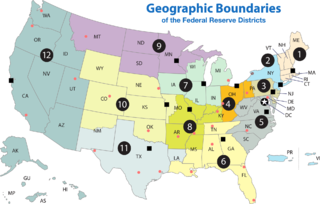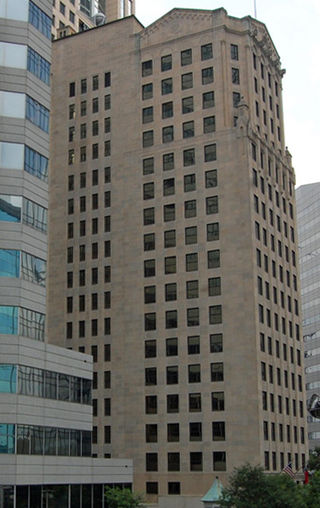
The Federal Reserve System is the central banking system of the United States. It was created on December 23, 1913, with the enactment of the Federal Reserve Act, after a series of financial panics led to the desire for central control of the monetary system in order to alleviate financial crises. Over the years, events such as the Great Depression in the 1930s and the Great Recession during the 2000s have led to the expansion of the roles and responsibilities of the Federal Reserve System.

Charlotte is the most populous city in the U.S. state of North Carolina. Located in the Piedmont region, it is the county seat of Mecklenburg County. The population was 874,579 at the 2020 census, making Charlotte the 15th-most populous city in the United States, the seventh-most populous city in the South, and the second-most populous city in the Southeast behind Jacksonville, Florida. The city is the cultural, economic, and transportation center of the Charlotte metropolitan area, whose 2020 population of 2,660,329 ranked 22nd in the United States. Metrolina is part of a sixteen-county market region or combined statistical area with a 2020 population of 2,822,352.

A Federal Reserve Bank is a regional bank of the Federal Reserve System, the central banking system of the United States. There are twelve in total, one for each of the twelve Federal Reserve Districts that were created by the Federal Reserve Act of 1913. The banks are jointly responsible for implementing the monetary policy set forth by the Federal Open Market Committee, and are divided as follows:

The Bank of America Corporation is an American multinational investment bank and financial services holding company headquartered at the Bank of America Corporate Center in Charlotte, North Carolina, with investment banking and auxiliary headquarters in Manhattan. The bank was founded in San Francisco, California. It is the second-largest banking institution in the United States, after JPMorgan Chase, and the second-largest bank in the world by market capitalization. Bank of America is one of the Big Four banking institutions of the United States. It serves approximately 10.73% of all American bank deposits, in direct competition with JPMorgan Chase, Citigroup, and Wells Fargo. Its primary financial services revolve around commercial banking, wealth management, and investment banking.

The United States Bullion Depository, often known as Fort Knox, is a fortified vault building located next to the United States Army post of Fort Knox, Kentucky. It is operated by the United States Department of the Treasury. The vault is used to store a large portion of the United States' gold reserves as well as other precious items belonging to or in custody of the federal government. It currently holds roughly 147 million troy ounces of gold bullion, a little over half the total gold presently held by the federal government. The United States Mint Police protects the depository.

The Federal Reserve Bank of New York is one of the 12 Federal Reserve Banks of the United States. It is responsible for the Second District of the Federal Reserve System, which encompasses the State of New York, the 12 northern counties of New Jersey, Fairfield County in Connecticut, Puerto Rico, and the U.S. Virgin Islands. Located at 33 Liberty Street in Lower Manhattan, it is by far the largest, the most active, and the most influential of the Reserve Banks.

The Federal Reserve Bank of St. Louis is one of 12 regional Reserve Banks that, along with the Board of Governors in Washington, D.C., make up the United States' central bank. Missouri is the only state to have two main Federal Reserve Banks.

The Federal Reserve Bank of Richmond is the headquarters of the Fifth District of the Federal Reserve located in Richmond, Virginia. It covers the District of Columbia, Maryland, North Carolina, South Carolina, Virginia, and most of West Virginia excluding the Northern Panhandle. Branch offices are located in Baltimore, Maryland and Charlotte, North Carolina. Thomas I. Barkin became president of the Richmond Fed following the retirement of Jeffrey M. Lacker in April 2017. The previous president, J. Alfred Broaddus, retired in 2004.

The Federal Reserve Bank of Chicago is one of twelve Federal Reserve Banks that, along with the Federal Reserve Board of Governors, make up the Federal Reserve System, the United States' central bank. The Chicago Fed serves the Seventh District, which encompasses the northern portions of Illinois and Indiana, southern Wisconsin, the Lower Peninsula of Michigan, and the state of Iowa. In addition to participation in the formulation of monetary policy, each Reserve Bank supervises member banks and bank holding companies, provides financial services to depository institutions and the U.S. government, and monitors economic conditions in its District.

Uptown Charlotte, also called Center City, is the central business district of Charlotte, North Carolina, United States. The area is split into four wards by the intersection of Trade and Tryon Streets, and bordered by Interstate 277 and Interstate 77. The area is managed and overseen by the Charlotte Central City Partners, which is one of the three Municipal Service Districts in Charlotte. Uptown Charlotte is the largest business district in Charlotte and the Carolinas.

The National Audiovisual Conservation Center, also known as the Packard Campus for Audio-Visual Conservation, is the Library of Congress's audiovisual archive located inside Mount Pony in Culpeper, Virginia.
The Mint Museum, also referred to as The Mint Museums, is a cultural institution comprising two museums, located in Charlotte, North Carolina. The Mint Museum Randolph and Mint Museum Uptown, together these two locations have hundreds of collections showcasing art and design from around the globe.

The Federal Reserve Bank of New York Building, also known as 33 Liberty Street, is a building in the Financial District of Lower Manhattan in New York City, which serves as the headquarters of the Federal Reserve Bank of New York. The building occupies the full block between Liberty, William, and Nassau Streets and Maiden Lane; it narrows at its east end, following the footprint of the block.

112 Tryon Plaza is a 280 feet (85 m) 22-story high-rise in Charlotte, North Carolina. It was the second tallest building in North Carolina when completed in 1927, and the tallest building in Charlotte for about 35 more years. It is currently the 21st tallest building in the city. Located on "The Square" at the corner of Trade St. and Tryon St. adjacent to a pocket park, this building has a premiere location in Uptown Charlotte, also known as Charlotte center city. In 2006 it was sold for $12 million to the Simpson Organization.
First National Bank of Charlotte was a bank located in Charlotte, North Carolina from 1865 until 1930.
The Federal Reserve Bank of Cleveland Pittsburgh Branch Office is one of two Federal Reserve Bank of Cleveland branch offices. The Pittsburgh Office of the Federal Reserve Bank of Cleveland hosts one of two savings bonds processing sites in the nation. The Pittsburgh branch presides over Jefferson, Monroe and Belmont counties in Ohio, Wetzel, Tyler, Pleasants, Marshall, Ohio, Brooke and Hancock counties in West Virginia, and all of Western Pennsylvania. In 1915 it was revealed that the Pittsburgh branch location was to be the new home of a relocated Cleveland Fed District with a majority vote secured on the board of governors, but the U.S. Attorney General at the time nixed moving the Cleveland, Kansas City, Minneapolis, Boston and Atlanta Federal Reserve Districts, stating that it would instead take an act of Congress to move those district headquarters. Pittsburgh remained a branch location only.

The Federal Reserve Bank of Richmond Baltimore Branch Office is one of the two Federal Reserve Bank of Richmond branch offices. The Federal Reserve Bank of Richmond's Baltimore Branch is an operational and regional center for Maryland, the metropolitan Washington D.C. area, Northern Virginia, and northeastern West Virginia. The Baltimore branch is part of the Fifth District and has the code E5. It supports Check 21 operations, supplies coin and currency to financial institutions and works to maintain stability in the financial sector throughout the Fifth District and also works with local elected officials and non-profit organizations to support fair housing initiatives throughout the Fifth District. The Baltimore branch was founded in March 1918 and is currently headed by William R. Roberts.
The East Rutherford Operations Center (EROC) at 100 Orchard Street, East Rutherford, New Jersey, is the regional office for cash handling and banknote processing of the Federal Reserve Bank of New York. The facility, which was constructed by Torcon in the early 1990s, features a 400,000-square-foot (37,000 m2) three-story structure which sits on 13 acres. The structure is designed to house fail-safe operations in a secure environment. The facility also has a state-of-the art automated vault measuring one million cubic feet, used for storing United States currency. The vault is based on an automated storage and retrieval system (AS/RS) and can hold at least USD 60 billion. Internally, the cash is transferred by automated guided vehicles (AGV).
The Clearing House is a banking association and payments company owned by the largest commercial banks in the United States. The Clearing House is the parent organization of The Clearing House Payments Company L.L.C., which owns and operates core payments system infrastructure in the United States, including ACH, wire payments, check image clearing, and real-time payments through the RTP network, a modern real-time payment system for the U.S.

The Federal Reserve Bank Building, also known as the Federal Reserve Bank of San Francisco, Seattle Branch, served as the offices of the Seattle branch of the Federal Reserve Bank of San Francisco for over 50 years, from 1951 to 2008.













